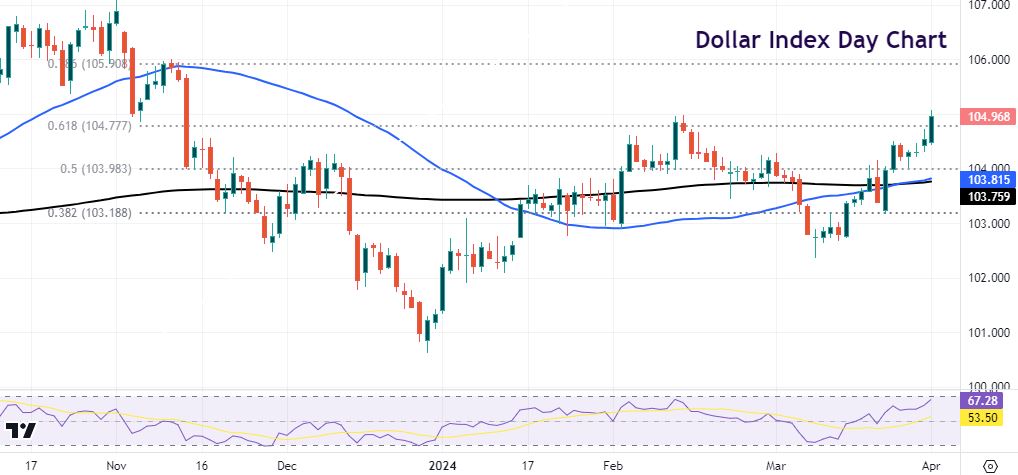USD breaks higher, so too Gold as inflation fears reignite

Headlines
* US Dollar rallies to fresh cycle highs on manufacturing strength
* Stocks mixed as interest rate cut optimism fades
* Gold rises to new record as inflation concerns re-emerge
* Main focus this week on Powell and March employment data
FX: USD broke to the upside and made fresh year-to-date highs above 105. Much stronger than expected ISM manufacturing data saw USD buying pick up sharply. The headline number rose above 50 into expansion territory for the first time since November 2022. Importantly, the prices paid component also rose strongly to the highest level since July 2022. New orders and production also leapt out of contraction. ISM Services are released on Wednesday with NFP on Friday.
EUR dropped to a low last seen in mid-February. The year-to-date bottom is at 1.0694. We heard from an ECB hawk who said cutting rates ahead of the Fed was not without risk. The region’s inflation data is released on Wednesday. There could be some price gains, though the disinflation trend is still expected.
GBP got hit in line with the broader tone of strength in USD. Cable has moved down below its 200-day SMA at 1.2589. This has acted as decent support on several occasions in February and March this year. The early February year-to-date low is 1.2518.
USD/JPY continues to hover just below the 2022 intervention high around 152. Last week’s top was at 151.97. US 10-year Treasury yields picked up sharply on the back of the stronger ISM data. They are approaching strong long-term resistance around 4.33%. Verbal intervention by the various officials in Tokyo has continued.
AUD dipped for a third straight day even though China released better than expected PMI data over the weekend. Iron ore prices recovered strongly from early weakness. USD/CAD picked up but continues to trade in a relatively narrow range. There was another strong rejection of 1.36+ levels again last week.
Stocks: US equities closed mixed on the first trading day of the second quarter. The broad-based benchmark S&P 500 finished 0.20% lower at 5243. The tech-dominated Nasdaq 100 added 0.20% to close at 18,293. The Dow Jones settled 0.60% lower at 39,566. New quarter, more records? The S&P 500, Nasdaq and Dow Jones have been up five months in a row. That last happened in the Nasdaq in July 2023. A six-month streak last took place in May 2017. Telsa led losses in the megacaps while Alphabet gained 2.78%.
Asian futures are in the green. APAC stocks traded mixed. The Nikkei 225 closed at a two-week low and below the key psychological 40,000 level. Investors typically sell stocks to book profits on the first day of the Japanese financial year. The index is up 19% this year. Chinese stocks jumped to their biggest one-day gains in a month on better PMI data. It expanded at its fastest pace in 13 months in March. The Hang Seng was closed for a holiday.
Gold broke higher to another fresh new high at $2,265 in the early hours of trading. But prices turned lower after this with Treasury yields and the dollar going bid. Gold prices tend to move inversely with interest rates because as rates rise, gold as a non-yielding asset becomes relatively less attractive.
Day Ahead – RBA Minutes
The RBA minutes will be of interest even though the cash rate was left unchanged at 4.35%. Markets interpreted the tone of the meeting as dovish as the RBA said the “Board is not ruling anything in or out on interest rates.” This was a change to the previous line that “a further increase…cannot be ruled out”. Governor Bullock also refrained from hawkish surprises at the press conference. She noted recent data suggests they are on track, but the war isn’t won yet on inflation.
Ultimately, the RBA needs to be more confident that prices are coming down to consider a rate cut. Of course, this is similar to most other major central banks. Markets currently see the first rate cut in late summer, so later than other banks which have been primed for policy easing to start in June. The aussie turned lower yesterday through 0.65. A more hawkish RBA may underpin support for AUD, but momentum does look more bearish as USD strengthens.
Chart of the Day – Dollar Index to new highs
The widely watched dollar index has broken to fresh yearly highs on the back of yesterday’s stronger manufacturing data. This comes in a week full of important economic releases, including the ISM Services, and employment figures like JOLTs job vacancies and the monthly non-farm payrolls. Odds of a Fed June rate cut were cut back to near 50:50 at one point after the data. That was around a 65% chance before the ISM data.
The US Dollar Index is made up of six of its main trading partners. The euro has by far the biggest weighting with aorund 56%. Next is the yen and pound at around 12-13%. Seasonal weakness is typically seen in April. But the upside breakout looks good currently, if it can be sustained above the mid-Febraury tops and prior 2024 highs. A major Fib level of the Q4 sell-off also sits just below here at 104.77.

